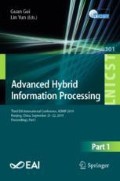Abstract
The traditional signal recognition method can not be quickly and efficiently identified by noise interference. In order to avoid the drawbacks of traditional methods, an intelligent identification method for short-wave communication transmission signals based on blind separation algorithm is proposed. According to the mathematical model, all the transmission signals in short-wave communication are modally decomposed, and the signal can be decomposed into functions of several different feature scales, and the time and frequency are extracted as the physical quantities of the signal characteristics. The blind separation algorithm is used for signal preprocessing. The short-time energy, short-term average amplitude and short-time zero-crossing rate are used as the starting point of the recognized speech signal. Under the fixed background noise, the normal signal and the noise signal are identified. It can be seen from the experimental results that the method has short recognition time and fast rate, which lays a foundation for short-wave communication transmission.
Access this chapter
Tax calculation will be finalised at checkout
Purchases are for personal use only
References
Chunhai, H., Xin, S., Liu, B., et al.: Research on P300 recognition algorithm based on wavelet transform and blind source separation. J. Metrol. 38(2), 12–15 (2017)
Tan, Y., Fan, H., Liu, M., et al.: Signal reconstruction of underwater wireless sensor networks based on blind source separation algorithm. Comput. Simul. 20(2), 173–176 (2018)
Bo Tang, Yu., Zhang, H.Z.: Research on blind separation algorithms of MIMO radar signals based on alternating projection. J. Electron. 45(9), 2092–2097 (2017)
Huang, Q., Hua, P., Li, T.P., et al.: Asymmetric PCMA blind separation algorithms based on soft information joint modification. J. Commun. 38(4), 178–189 (2017)
Wang, C., Jia, R., Zeng, Y., et al.: Study on separation of overlapping electromagnetic signals based on blind source separation algorithm. Electro-optic Control 13(2), 16–19 (2018)
Zhao, Z., Di, W.: Single channel BPSK signal blind separation algorithm using particle flow filtering. Data Acquis. Process. 33(3), 25–31 (2018)
Jing, Y., Liu, C., Bi, F.: Blind source separation and identification of radiated noise of generating units based on signal analysis. Intern. Combust. Engine Eng. 38(2), 141–145 (2017)
Guo, Y., Hua, P., Yong, Y., et al.: Blind separation algorithm for PCMA signals with different symbol rates based on DG-PSP. J. Commun. 38(3), 92–100 (2017)
Ling, Q., Zhang, L., Yan, W.: Research on blind recognition algorithm of STBC-OFDM signal based on improved K-S detection. J. Commun. 38(4), 46–54 (2017)
Xinyong, Yu., Guo, Y., Zhang, K., et al.: Multi-hop signal network sorting algorithm based on blind source separation. Sig. Process. 33(8), 1082–1089 (2017)
Yang, G., Jing, J., Yang, M., et al.: Blind vibration source separation algorithm using aeroengine signal characteristics. J. Xi’an Jiaotong Univ. 51(6), 20–27 (2017)
Wang, Yu., Li, X., Mao, Y., et al.: Radar signal research based on JADE blind source separation algorithm. Mod. Def. Technol. 45(1), 18–19 (2017)
Author information
Authors and Affiliations
Corresponding author
Editor information
Editors and Affiliations
Rights and permissions
Copyright information
© 2019 ICST Institute for Computer Sciences, Social Informatics and Telecommunications Engineering
About this paper
Cite this paper
Hu, Ys. (2019). Intelligent Recognition Method of Short Wave Communication Transmission Signal Based on the Blind Separation Algorithm. In: Gui, G., Yun, L. (eds) Advanced Hybrid Information Processing. ADHIP 2019. Lecture Notes of the Institute for Computer Sciences, Social Informatics and Telecommunications Engineering, vol 301. Springer, Cham. https://doi.org/10.1007/978-3-030-36402-1_50
Download citation
DOI: https://doi.org/10.1007/978-3-030-36402-1_50
Published:
Publisher Name: Springer, Cham
Print ISBN: 978-3-030-36401-4
Online ISBN: 978-3-030-36402-1
eBook Packages: Computer ScienceComputer Science (R0)

